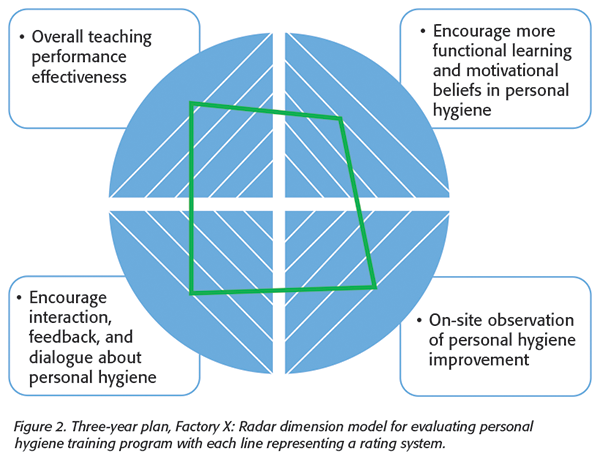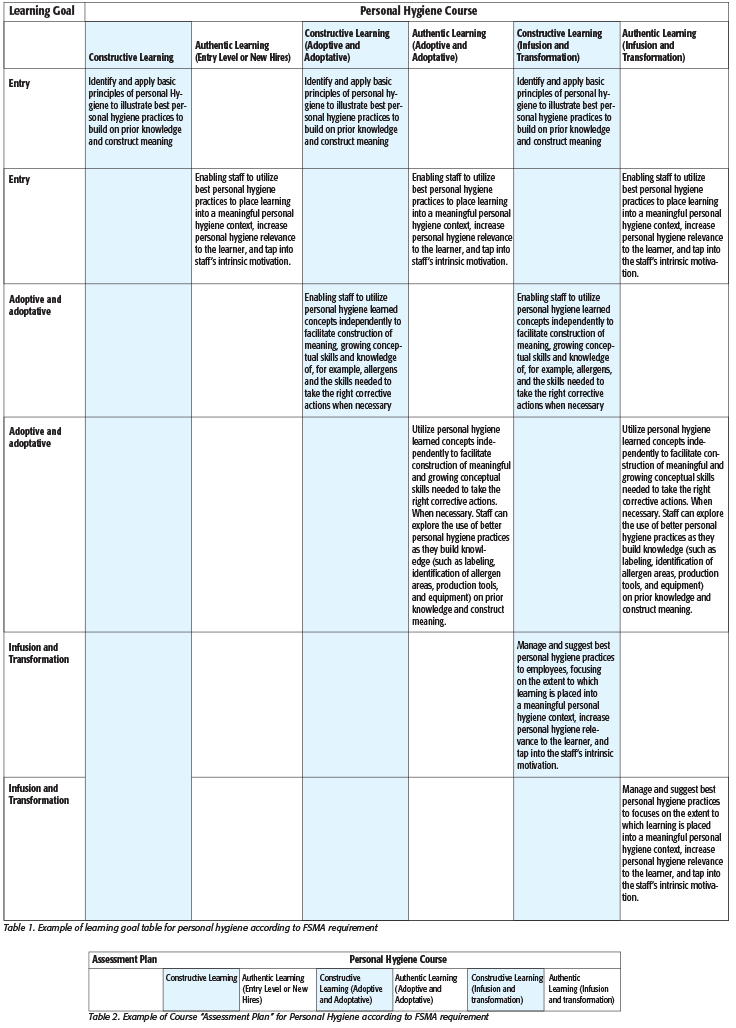In parts one and two of this three-part series, we discussed the importance of integrating technology applications for design and delivery in food safety training in accordance with the Food Safety Modernization Act (FSMA). Food safety education according to the U.S. Food and Drug Administration (FDA) must include 24 learning outcomes from FSMA Preventive Controls for Human Foods rule, covering personal hygiene, building and equipment construction, ingredient and finished product storage, cleaning and sanitizing of processing equipment and utensils (a preventive control), and so on. We have developed an example of the educational plan using personal hygiene. Although effective development and delivery could help improve food safety training, without the proper development of evaluation criteria of the food safety training effectiveness, the programs might not provide the desired outcome. In order to meet training objectives, a food facility must enlist experts in both in the subject matter as well as training development, delivery and assessment in the design of a comprehensive and productive FSMA food safety training program.
Importance of Training Assessment and Evaluation
Assessing a food safety training plan provides an opportunity for continuous improvement as plant departments can identify areas in need of performance improvements that can best be satisfied by FSMA-focused training. There are various tools to assess training effectiveness, which allow for the collection of information and determination of whether student learning outcomes/goals were achieved. A minimum of three learning outcomes should be used to verify assessment results.
Once the assessment is complete, planning can begin for strategies to improve training, resulting in better productivity and improved employee performance. It will also help companies understand how to allocate educational spending for satisfying the various FSMA requirements. Food safety training assessments should include these five steps:
Step 1: Identify key stakeholders, solicit support, and prepare the project plan
Step 2: Describe desired behavioral needs, outcomes, and goals that will contribute to the FSMA requirement
Step 3: Obtain needs assessment data (e.g., review strategic plans, FSMA requirement, assess HR metrics, review job descriptions) and success measure and program milestones
 Step 4: Screen the on-site results and report it in measurable data (Figure 1)
Step 4: Screen the on-site results and report it in measurable data (Figure 1)
Step 5: Determine corrective actions for insufficient training and plan to improve the
issues in the training goals and objectives
The results of the assessment allow the training manager to set the new short-term training goals, objectives, and action plans to move the company forward in reaching the company’s long-term goals (Figure 2).
 It is possible that the detected performance gap is not completely training related, but may include other areas such as communications, providing a supportive work environment, and mismatched job fit. In these cases, interventions other than training may also be needed to achieve new performance levels at all levels of the organization.
It is possible that the detected performance gap is not completely training related, but may include other areas such as communications, providing a supportive work environment, and mismatched job fit. In these cases, interventions other than training may also be needed to achieve new performance levels at all levels of the organization.
In this example, a multi-dimensional process for evaluating an overall personal hygiene training performance is described below. A multi-dimensional process is strongly recommended as the dynamics will be helpful for assessing the Food Safety training goal (Tables 1 and 2).

In Figure 2, the personal hygiene program assessment will be evaluated using a five-scale rating system from 1 (Poor), 2 (Fair), 3 (Average), 4 (Good), and 5 (Excellent) in a 3-year educational plan with the following four proposed categories:
1) Overall teaching performance effectiveness
2) Encouragement of more functional learning and motivational beliefs, in this example, personal hygiene
3) Encourage interaction, feedback, and dialogue about personal hygiene
4) On-site assessment of the teaching objective result, in this example, personal hygiene.
There are a number of available assessment techniques; some that work particularly well are listed below. Whichever technique is chosen, ensure that the food safety training is implemented with practical and relevant information:
A. Direct Assessment Methods:
Rubrics, scoring: In this technique, the assessment could be developed based on a rubric.
Performance: Perform a task rather than select an answer from a ready-made list.
Portfolio: Learners work together with their trainers as an alternative to the classic classroom test.
Pre- and post-test: The exam is administered at the beginning and at the end of a course or program in order to determine the progress of student learning.
B. Indirect Assessment Methods:
Course evaluation surveys: Assess student experience and satisfaction with an individual course and are administered at or near the end of the semester.
Focus group: Students will be asked open-ended questions about beliefs, attitudes, and experiences about the learning objective.
Map matrices: Using columns and row to generate a progressive map on students’ achievements.
SWOT analysis: A map for assessing the internal strengths and weaknesses of the course, program, department, as well as external threats and opportunities.
Reviewing a syllabus: This is done to determine whether the course is meeting the goals and outcomes of the learning objectives.
In this section, we will introduce “real time” assessment techniques by experts for a better estimate of training progress and to modify/improve course content, adjust teaching methods, and, ultimately improve the food safety training quality.
Examples of Food Safety Knowledge and Skills Assessments
One-Minute Paper: Ask students about most important thing he/she learned today and what he /she understood least. Use the information to clarify, correct, or elaborate.
Application Article: Ask students to write a short article about application of the major points of the class during last 15 minutes of class and major point applies to a real-world situation.
Examples of Food Safety Knowledge Assessment of Student Attitudes, Values, and Self-Awareness
These are used to capture students’ thoughts and record only attitudes, values, and self-awareness.
Suggestion Box: Have a box to receive any class related issues. Review and respond during the next class session.
Exam Evaluations: Ask students to evaluate how a regularly planned tests could measure their knowledge or skills.
Student Rep Group: Ask students to volunteer to meet as a small group with the trainer a regular basis to discuss how the course is progressing, what they are learning, and suggestions for improving the course. Some issues will be specific to the trainer while others may need to be addressed in class.
Developing a Curriculum Map
One of the important parameters in a training program assessment is developing the training matrix. Continual and repetitive hygiene and Food Safety education could be effective by reinforced frequency of food safety training and more suitable for the employees’ educational background.
Effective assessment techniques and evaluation of food safety training programs will better enable companies to meet the intent of FDA’s FSMA requirements. Assessment tools, however, demand specialized design and in-depth understanding of the various staff levels, responsibilities, materials, content, and the facility environment. Now that training assessment and evaluations are required, a more productive and scientific approach is in order to verify fulfillment. While there is no single formula for training that will match each individual food plant, with a certain amount of adjustment in the design and training assessment of a common food training program needed, the food safety training program for all food plants will utilize similar education and training principles and evaluation criteria. Whether choosing to take the steps to develop a comprehensive training program in-house or consulting with an outside expert who facilitates training programs for you, it is essential to adjust the training program and improve the training program quality using “best practice” tools, methods, and scientific advice to ensure your facility’s training programs make the grade.
Mehrdad Tajkarimi, D.V.M., M.P.V.M., Ph.D., is an expert in national and international food safety regulations, warehouse and wholesale manufacturing, and the dairy, grain, poultry, and retail industries. He assists clients with organic requirements, FSMA, and natural food preservatives and packaging, foodborne pathogenic and spoilage microorganism characteristics, and shelf-life studies. He is an independent consultant to the EAS Consulting Group.
Resources
www.wssu.edu/about/assessment-and-research/niloa/_files/documents/assessmentmethods.pdf.
www.celt.iastate.edu/teaching/assessment-and-evaluation/classroom-assessment-techniques-quick-strategies-to-check-student-learning-in-class/.
www.bu.edu/provost/files/2017/06/Creating-Learning-Outcomes-Stanford.pdf.




